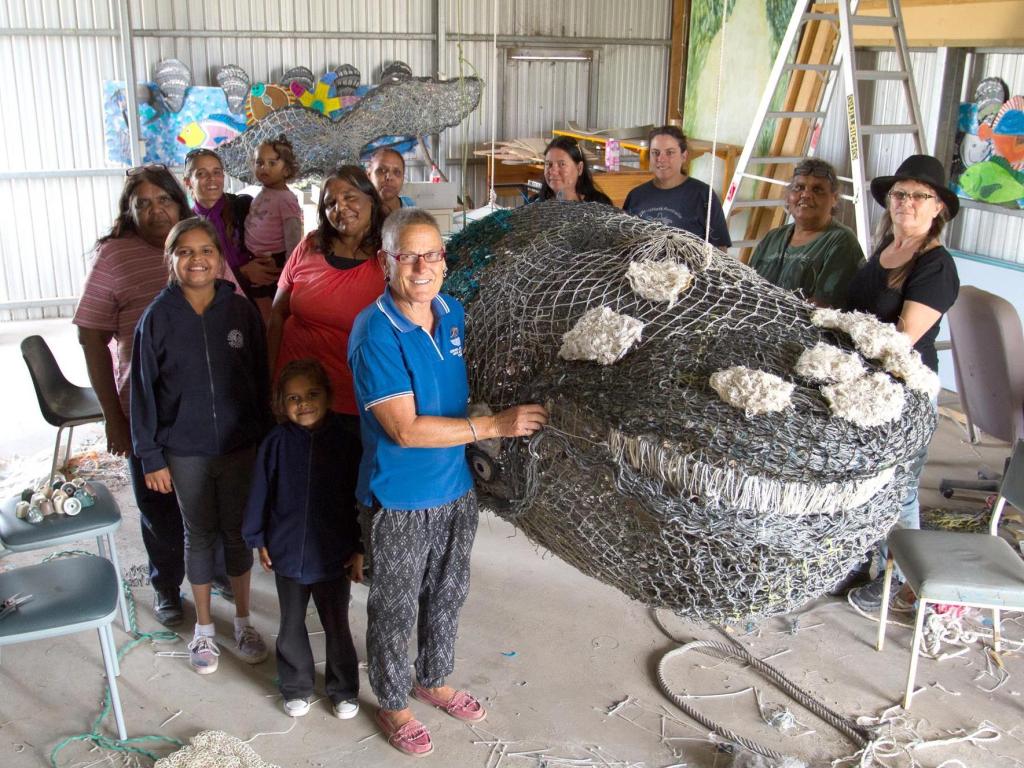Artists in workshops in Ceduna, image courtesy of Ananguku Arts.
Ananguku Arts and Cultural Aboriginal Corporation (Ku Arts) a South Australian Aboriginal artists’ organisation, is looking forward to supporting TARNANTHI, the inaugural Festival of Contemporary Aboriginal and Torres Strait Islander Art, opening at the Art Gallery of South Australia and across Adelaide from 8 October 2015.
The Festival will also mark the 10th anniversary of Our Mob at the Adelaide Festival Centre. Our Mob is the annual statewide exhibition of contemporary art by Aboriginal and Torres Strait Islander artists living and working in South Australia. In 2006 Ku Arts and the Statewide Indigenous Community Artists’ Development program (SICAD) worked together with the Adelaide Festival Centre and Country Arts SA to start the exhibition.
South Australia is the gateway to the Western Desert where many of Australia’s leading Indigenous artists live in remote communities and homelands. The region is a driving force in the contemporary art movement. The paintings of senior Aboriginal artists are grounded in the Manta, (Earth, Land) – they are stories of Tjukurpa, the Law or Dreaming, from Anangu, a people who celebrate unbroken ties with the Manta (Land, earth) stretching back tens of thousands of years and celebrated through art making since that time. Now, younger emerging artists working beside the old people are exploring a range of media and subjects which may range from interpreting the stories handed down by their grandparents to the personal, political and quirky.
Aboriginal art centres are both professional development studios and hubs of community activity. Art-making persists as the largest and sometimes only source of private income for artists and their families in the APY art centres of Ninuku, Tjungu Palya, Tjala Arts, Ernabella Arts, Kaltjiti, Mimili Maku and Iwantja Arts.
The rich tradition of art-making by South Australian Aboriginal artists is not restricted to the APY Lands. Artists at Tjutjuna Arts and Crafts at Ceduna in the far west of the State make vibrant work in a range of media and there are arts projects operating across regional centres including Coober Pedy, Port Augusta, Whyalla, Port Lincoln and Mt Gambier.
Ku Arts is proud of the role the organisation has played in the contemporary Indigenous visual arts movement over the last eighteen years, supporting and starting up art centres in remote communities and providing professional development opportunities for Indigenous artists where there are no art centres. Ku Arts and SICAD deliver an ongoing support program of professional development opportunities, marketing and advocacy for art centres and for artists.
Director of Ananguku Arts Alison Milyika Carroll, who is an accomplished ceramicist and artist, says that everyone is looking forward to the TARNANTHI Festival and Our Mob. ‘It is good to get together with other artists and curators, from all over the country, to see new work and to meet the people who collect our work,’ said Mrs Carroll.
TARNANTHI, the inaugural Festival of Contemporary Aboriginal and Torres Strait Islander Art, opens at the Art Gallery of South Australia and across Adelaide from 8 October 2015.
Ananguku Arts will support an Art Fair stall at Tandanya for South Australian artists who are not represented by art centres on 9 & 10 October.
Our Mob will be open on Saturday 10 October at the Adelaide Festival Centre with a tenth anniversary celebration on Monday 12, after the Visual Arts Symposium.
For more information visit Ananguku Arts.





